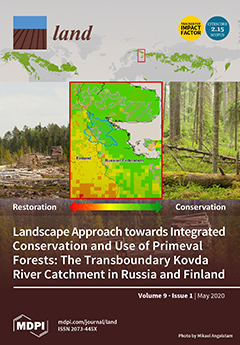Resources
Displaying 1451 - 1455 of 2258Revisiting the Determinants of Pro-Environmental Behaviour to Inform Land Management Policy: A Meta-Analytic Structural Equation Model Application
Environmental policies in the realm of land management are increasingly focussing on inducing behavioural change to improve environmental management outcomes. This is based, implicitly or explicitly, on theories that suggest that pro-environmental behaviour can be understood, predicted and altered based on certain factors (referred to as determinants of pro-environmental behaviour). However, studies examining the determinants of pro-environmental behaviour have found mixed evidence.
On How Crowdsourced Data and Landscape Organisation Metrics Can Facilitate the Mapping of Cultural Ecosystem Services: An Estonian Case Study
Social media continues to grow, permanently capturing our digital footprint in the form of texts, photographs, and videos, thereby reflecting our daily lives. Therefore, recent studies are increasingly recognising passively crowdsourced geotagged photographs retrieved from location-based social media as suitable data for quantitative mapping and assessment of cultural ecosystem service (CES) flow. In this study, we attempt to improve CES mapping from geotagged photographs by combining natural language processing, i.e., topic modelling and automated machine learning classification.
Delivering Climate-Development Co-Benefits through Multi-Stakeholder Forestry Projects in Madagascar: Opportunities and Challenges
This paper explores multi-stakeholder perspectives on the extent to which forestry projects that pursue ecological restoration and rehabilitation in Madagascar engage with local communities and can co-deliver climate-development benefits. Drawing on mixed methods (policy analysis, semi-structured interviews, participatory site visits and focus groups) in two different forestry contexts, we show that by strengthening access to capital availability, projects can enhance local adaptive capacity and mitigation and deliver local development.
Can Rock-Rubble Groynes Support Similar Intertidal Ecological Communities to Natural Rocky Shores?
Despite the global implementation of rock-rubble groyne structures, there is limited research investigating their ecology, much less than for other artificial coastal structures. Here we compare the intertidal ecology of urban (or semi-urban) rock-rubble groynes and more rural natural rocky shores for three areas of the UK coastline. We collected richness and abundance data for 771 quadrats across three counties, finding a total of 81 species, with 48 species on the groynes and 71 species on the natural rocky shores.
Landscape Approach towards Integrated Conservation and Use of Primeval Forests: The Transboundary Kovda River Catchment in Russia and Finland
Regional clear-felling of naturally dynamic boreal forests has left remote forest landscapes in northern Europe with challenges regarding rural development based on wood mining. However, biodiversity conservation with higher levels of ambition than what is possible in regions with a long forest history, and cultural heritage, offer opportunities for developing new value chains that support rural development.


